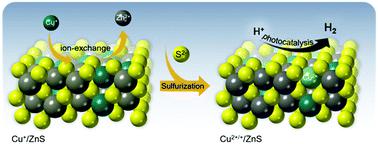当前位置:
X-MOL 学术
›
Inorg. Chem. Front.
›
论文详情
Our official English website, www.x-mol.net, welcomes your
feedback! (Note: you will need to create a separate account there.)
Surface defect engineering of mesoporous Cu/ZnS nanocrystal-linked networks for improved visible-light photocatalytic hydrogen production
Inorganic Chemistry Frontiers ( IF 6.1 ) Pub Date : 2020-10-09 , DOI: 10.1039/d0qi01013h Ioannis Daskalakis 1, 2, 3, 4 , Ioannis Vamvasakis 1, 2, 3, 4 , Ioannis T. Papadas 5, 6, 7, 8, 9 , Sotirios Tsatsos 4, 10, 11, 12, 13 , Stelios A. Choulis 5, 6, 7, 8, 9 , Stella Kennou 4, 10, 11, 12, 13 , Gerasimos S. Armatas 1, 2, 3, 4
Inorganic Chemistry Frontiers ( IF 6.1 ) Pub Date : 2020-10-09 , DOI: 10.1039/d0qi01013h Ioannis Daskalakis 1, 2, 3, 4 , Ioannis Vamvasakis 1, 2, 3, 4 , Ioannis T. Papadas 5, 6, 7, 8, 9 , Sotirios Tsatsos 4, 10, 11, 12, 13 , Stelios A. Choulis 5, 6, 7, 8, 9 , Stella Kennou 4, 10, 11, 12, 13 , Gerasimos S. Armatas 1, 2, 3, 4
Affiliation

|
Transition metal sulfides have been emerging as one of the most attractive and prospective catalysts for the direct conversion of solar energy into chemical fuels. Their intriguing compositional and electronic characteristics and their feasibility for integration in porous architectures endow metal sulfide materials with superior activity for photochemical catalysis. In the present work, high-surface-area Cu-doped ZnS nanocrystal (NC)-linked mesoporous frameworks are successfully synthesized for use as cost-effective catalysts for photochemical hydrogen evolution. Benefiting from the suitable band-edge alignment and enhanced visible light absorption resulting from the interfacial charge transfer between ZnS and Cu2S NCs, there is a spatial separation of charge carriers which leads to excellent activity for photocatalytic hydrogen production. Moreover, the results obtained here show that surface defect passivation through a wet-chemical sulfidation process effectively increases the photochemical performance of the composite catalysts by improving the transport efficiency of electrons at the Cu2S/ZnS interface and changing the Helmholtz layer potential drop at the ZnS/Cu2S/electrolyte junction. Thus, a remarkable improvement of 1 mmol h−1 gcat−1 for hydrogen evolution is observed with the sulfide-treated Cu2S/ZnS catalyst containing 5 mol% Cu, which is associated with a 17.6% apparent quantum yield under 410 nm irradiation. This work provides an interesting strategy for enhancing the interface charge transfer properties and hydrogen evolution activity of metal sulfides by surface defect engineering with sulfide ions.
中文翻译:

介孔Cu / ZnS纳米晶连接网络的表面缺陷工程可改善可见光光催化制氢
过渡金属硫化物已成为将太阳能直接转化为化学燃料的最有吸引力和最有前景的催化剂之一。它们有趣的组成和电子特性以及在多孔结构中集成的可行性赋予了金属硫化物材料以优异的光化学催化活性。在当前的工作中,成功地合成了高表面积的掺杂Cu的ZnS纳米晶体(NC)连接的介孔骨架,以用作光化学氢气析出的经济有效的催化剂。得益于ZnS和Cu 2之间的界面电荷转移,合适的带边对准和增强的可见光吸收在S NCs中,存在电荷载流子的空间分离,这导致了光催化制氢的出色活性。此外,此处获得的结果表明,通过改进化学催化剂在Cu 2 S / ZnS界面处的电子传输效率并改变Helmholtz层电位下降,通过湿化学硫化工艺进行的表面缺陷钝化可有效提高复合催化剂的光化学性能。ZnS / Cu 2 S /电解质结。因此,通过硫化物处理的Cu 2,观察到氢气释放的1 mmol h -1 g cat -1显着改善。含5 mol%Cu的S / ZnS催化剂,在410 nm辐照下的表观量子产率为17.6%。这项工作提供了一种有趣的策略,可通过使用硫化物离子进行表面缺陷工程来增强金属硫化物的界面电荷转移性能和氢释放活性。
更新日期:2020-11-03
中文翻译:

介孔Cu / ZnS纳米晶连接网络的表面缺陷工程可改善可见光光催化制氢
过渡金属硫化物已成为将太阳能直接转化为化学燃料的最有吸引力和最有前景的催化剂之一。它们有趣的组成和电子特性以及在多孔结构中集成的可行性赋予了金属硫化物材料以优异的光化学催化活性。在当前的工作中,成功地合成了高表面积的掺杂Cu的ZnS纳米晶体(NC)连接的介孔骨架,以用作光化学氢气析出的经济有效的催化剂。得益于ZnS和Cu 2之间的界面电荷转移,合适的带边对准和增强的可见光吸收在S NCs中,存在电荷载流子的空间分离,这导致了光催化制氢的出色活性。此外,此处获得的结果表明,通过改进化学催化剂在Cu 2 S / ZnS界面处的电子传输效率并改变Helmholtz层电位下降,通过湿化学硫化工艺进行的表面缺陷钝化可有效提高复合催化剂的光化学性能。ZnS / Cu 2 S /电解质结。因此,通过硫化物处理的Cu 2,观察到氢气释放的1 mmol h -1 g cat -1显着改善。含5 mol%Cu的S / ZnS催化剂,在410 nm辐照下的表观量子产率为17.6%。这项工作提供了一种有趣的策略,可通过使用硫化物离子进行表面缺陷工程来增强金属硫化物的界面电荷转移性能和氢释放活性。









































 京公网安备 11010802027423号
京公网安备 11010802027423号